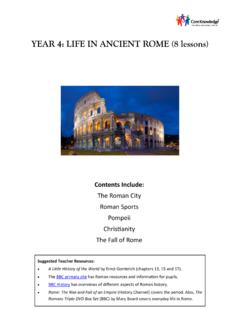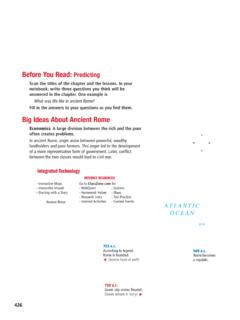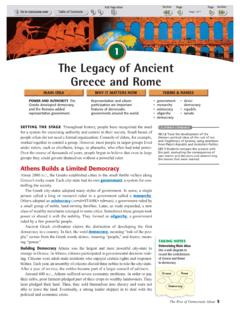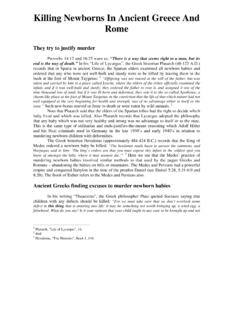Transcription of Life as a in - Weebly
1 10/14/2014 life as a Plebeian in ancient Rome: iCONN OneSearch for Public &EducationPersonalRelationships &Family LifeLiving QuartersTypical AppearanceTypical MealsTypical EarningsTypical DaySocietal StandingPersonal TimeReligious LifePolitical LifeBibliographyLife as a Plebeian in ancient Rome ancient Roman Plebeians at a GlanceScholars typically categorize ancient Roman history into three distinct time periods: the era ofthe kings, the Roman Republic, and the Roman Empire. The date of Rome's founding istraditionally given as 753 BCE, coincident with the beginning of the regal era.
2 The overthrowof Rome's seventh king in 509 BCE marked the beginning of the Roman Republic, whichlasted for almost five centuries. During this era, plebeians (or common people) gainedpolitical and social clout. Although scholars disagree on the precise beginnings of the RomanEmpire, most acknowledge Caesar Augustus, who reigned from c. 27 BCE until 14 CE, as thefirst emperor. Invaders deposed the final Roman emperor in 476 Period Dates: 753 BCE-476 CETime Period Name: ancient RomeGeographic Location: At its height at the death of Emperor Trajan in 117 CE, the RomanEmpire encompassed forty provinces that included parts of forty modern-daycountries.
3 Rome had under its control the Mediterranean Sea and all lands bordering it,including the provinces of Tarraconensis, Baetica, and Lusitania on the Iberian Peninsula(modern-day Spain); the whole Mediterranean coast of North Africa, divided into the provincesof Africa, Mauretania, Numidia, Cyrenaica, and Aegyptus; the entire lands of Asia Minor(modern-day Turkey) in the east; portions of the modern-day Middle East, including Israel,Syria, and parts of Armenia and Iraq; and, in the north, Britannia (modern-day England), Gaul,which now comprises much of west-central Europe, and the province of Germania, ending atthe Rhine River.
4 The Roman Empire also encompassed modern-day Italy and Greece, and the Roman provinces ofMoesia, Thrace, and Dacia which make up the current Balkan Rank: PlebeianTypical life Span: Historians have estimated that one-third of all infants and as many as half of all Roman childrendied before reaching adulthood. Those who survived until their teen years could expect to live until age 55-65, althoughmany died younger and a few lived into advanced old & EducationFathers exercised absolute control over their children. Although evidence indicates that Roman children had opportunitiesto play, working-class children, or the children of Roman plebs, were more than likely thrust into adulthood at a relativelyyoung age.
5 Some scholars have argued that although Romans loved their children, they may have been more valued fortheir potential to care for their parents later in life , which might be particularly true of the plebeian among the lower classes received only a limited education, perhaps learning the basics of reading, writing andmathematics from their parents. From about the third century BCE, wealthier families could afford to send their children toschools or hire a tutor. Schools accepted both boys and girls, although boys composed much of the student typically ended in the Relationships & Family LifeAt all levels of society, the paterfamilias (literally the father of the family) held the ultimate authority in his household,especially as it concerned more weighty matters as marriage, divorce and women held a subservientposition to their fathers and husbands, and sons had no authority over their fathers, even in Accent10/14/2014 life as a Plebeian in ancient Rome.
6 ICONN OneSearch for Public the passage of the Lex Canuleia in 445 BCE, Roman law banned marriage between plebeiansand patricians. (Thelaw also allowed for children to inherit their father's class.) Although Roman youths could legally marry as young as agetwelve or fourteen, most plebeians were much older by the time of their marriage. Ceremonies were common, with brideand groom declaring their intent to live as a married couple before family and friends gathered at the bride's family marriages could be legally dissolved through divorce, most marriages resulted in children.
7 The emperor Augustus, astrong proponent of traditional Roman family values, began granting special privileges to the parents of multiple children toencourage higher birth QuartersThe vast majority of Roman plebeians lived in apartments located in buildings called insulae (the Latin word for "islands").During the Roman Republic, these buildings stretched up to seven stories, though the emperor Augustus later capped theirheight at five stories. The ground floor often contained retail shops, with single or multi-room apartments filling theremaining in Rome were considerably higher than those in outlying Italian or provincial cities, so even relatively well-off plebeians could often afford only small quarters.
8 Many apartments were cramped and unhealthy, with no running wateror heat. Natural light and fresh air came from windows looking onto a small central courtyard. The buildings themselvesfrequently caught fire or simply plebeians might instead have lived in detached houses called a domus. A spacious residence of this type wasusually arranged around an open courtyard and included separate rooms for dining, relaxing, cooking and sleeping. Brightlycolored murals typically decorated the public AppearancePlebeian men rarely had reason to wear the toga, which was mostly reserved for the upper classes and wealthy , a typical plebeian man wore a simple knee-length tunic, perhaps belted at the waist.
9 Plebeian women wore tunicsas well as a long dress called a stola. Both men and women wore loose cloaks during inclement weather. Romans favoredbright colors and liked to adorn themselves with jewelry, including brooches, rings, bracelets and Roman fashion changed little over the centuries, hairstyles and facial hair underwent periodic trends. Forexample, early plebeian men typically had beards, although a clean shaven look became the norm during the republicanera. The bearded emperor Hadrian again popularized facial hair during his reign in the early second century plebeian women used cosmetics made of natural substances such as chalk and charcoal to enhance theirappearances.
10 However, the extravagant hairstyles associated with some Roman eras would have been beyond thecapabilities of plebeian in the third century BCE, public baths became an essential service in all Roman cities. Men and women usedseparate facilities, and some large bath complexes included gymnasiums and other areas for exercise or recreation. Publictoilets were often located near public MealsPlebeians relied largely on a diet of bread, porridge and vegetables, supplemented by eggs, fruits, fish and poultry. Redmeat, such as pork or veal, was financially out of reach for much of Rome'sworking class.









